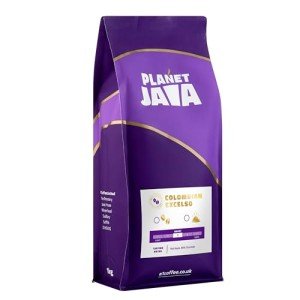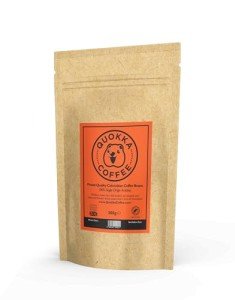Colombian coffee beans are known for their smooth flavor and rich aroma, making them a favorite for many coffee lovers. Grown in the lush mountains of Colombia, these beans offer a nice balance of sweetness and acidity that keeps you coming back for more. Whether you prefer a bold brew or a light cup, Colombian beans deliver that perfect pick-me-up every time.
Columbian Coffee Beans
Discover the rich and bold flavors of Colombian coffee that elevate your daily brew
Product List



Colombian Excelso Coffee Beans
Planet Java
Product Review Score
4.14 out of 5 stars
30 reviews£19.99


Quokka Colombian Medium Roast
Quokka Coffee
Product Review Score
4.93 out of 5 stars
62 reviews£9.45
Colombia, a country renowned for its spectacular landscapes and diverse culture, is equally celebrated for its world-class coffee beans. With a perfect combination of altitude, climate, and soil conditions, Colombian coffee has carved a niche for itself on the global stage. This blog post delves into the captivating world of Colombian coffee beans, exploring their history, cultivation process, flavor profile, and much more.
The Historical Context of Colombian Coffee
Colombian coffee production began in the late 18th century, but it wasn't until the mid-19th century that coffee exports became integral to Colombia's economy. Here’s a brief timeline highlighting significant moments in Colombian coffee’s history:
| Year | Event |
|---|---|
| 1730 | The first coffee seeds were brought to Colombia from the Caribbean. |
| 1835 | Coffee became Colombia's principal export. |
| 1927 | The National Federation of Coffee Growers of Colombia was established. |
| 2006 | Colombian Coffee is granted Denomination of Origin status, similar to wine regions in France. |
As cultivation spread throughout the country's mountainous regions, Colombian coffee became synonymous with quality and uniqueness.
The Geography of Colombian Coffee
Coffee in Colombia primarily thrives in a specific "Coffee Triangle," which comprises three major departments: Caldas, Quindío, and Risaralda. This region is characterized by:
- Altitude: Most Colombian coffee is grown at elevations between 1,200 and 1,800 meters (around 4,000 to 6,000 feet), lending to a slower maturation process.
- Climate: The climate is typically warm and wet, combining both a dry and a wet season, crucial for growing high-quality coffee beans.
- Soil: Rich volcanic soil enhances nutrient content and contributes to the beans' flavors.
The Colombian Coffee Bean: Varietals
Several coffee varietals flourish in Colombia, each offering distinct flavors and characteristics. Some of the most notable varietals include:
| Variety | Flavor Profile | Characteristics |
|---|---|---|
| Arabica | Fruity, floral notes with chocolate | Grown at high altitudes, smooth taste. |
| Castillo | Nutty, caramel undertones | Resistant to disease, well-rounded flavor. |
| Caturra | Bright acidity, sweet finish | Short and compact, but high yield. |
| Colombia | Balanced, sweet, medium body | Grown in diverse microclimates, rich flavor. |
Understanding the differences in these varietals helps to appreciate the diversity of Colombian coffee.
The Cultivation Process
The journey of Colombian coffee beans from farm to cup involves several meticulous steps.
- Planting: Coffee seedlings are planted in nurseries and transferred to the field when ready.
- Growing: Coffee plants require a consistent climate and sufficient rainfall; they typically take 3-4 years to bear fruit.
- Harvesting: Harvesting is usually done by hand, allowing pickers to select only the ripe cherries.
- Processing: The two main methods — washed (or wet) processing and natural processing — affect flavor.
- Drying: The coffee beans are then dried under the sun or with machines to reduce moisture.
- Milling: Finally, the beans are hulled, graded, and prepared for export.
Flavor Profiles: What to Expect
Colombian coffee has earned a reputation for its remarkable flavors and aromas. Here are some key flavor profiles frequently associated with Colombian coffee:
Flavor Characteristics:
- Acidity: Medium to high acidity, often bright and crisp.
- Body: Medium to full-bodied, offering a smooth mouthfeel.
- Flavor Notes: Typically includes fruity, nutty, or chocolaty flavors.
- Finish: Clean with a lingering sweetness.
Colombian coffee's consistency and quality in flavor have established it as one of the favorites among coffee enthusiasts globally.
The Impact of Colombian Coffee on the Economy
Colombian coffee is not only essential for the global coffee market but also significant for Colombia's economy, providing a livelihood for more than 500,000 families.
Economic Contributions:
- Exports: Coffee remains one of Colombia's top export products, significantly contributing to the nation’s GDP.
- Employment: Coffee farming provides employment for millions, particularly in rural areas.
- Cultural Importance: Coffee production is woven into the cultural fabric of Colombia and plays a role in the identity of many regions.
Challenges Facing Colombian Coffee
Despite its acclaim, Colombian coffee production faces challenges:
- Climate Change: Increasing temperatures and unpredictable rainfall can adversely affect coffee yield and quality.
- Coffee Leaf Rust: A fungal disease posing a huge risk to coffee crops.
- Market Fluctuations: Changes in coffee prices globally can impact farmers' income and sustainability.
FAQs About Colombian Coffee Beans
1. What makes Colombian coffee beans unique?
Colombian coffee beans are cultivated at high altitudes in ideal growing conditions, leading to their distinctive flavor profile characterized by a balance of acidity, sweetness, and aroma.
2. How are Colombian coffee beans processed?
Colombian coffee beans are primarily processed using the washed method, which enhances the brightness and clarity of flavors.
3. What is the best way to brew Colombian coffee?
Colombian coffee can be brewed using various methods, including pour-over, French press, and espresso. Each method highlights different flavor notes.
4. Are Colombian coffee beans sustainably harvested?
Many Colombian coffee producers are adopting sustainable farming practices to enhance environmental stewardship and economic viability. Certifications like Fair Trade and Rainforest Alliance help identify sustainably produced beans.
5. How can I properly store Colombian coffee beans?
To preserve flavor and freshness, store coffee beans in an airtight container in a cool, dark place away from moisture and heat.
Colombian coffee beans offer a rich tapestry of history, culture, and flavor that coffee lovers worldwide cherish. Their unique characteristics, coupled with urban and rural production processes, lend to an exceptional coffee experience. With increasing awareness of sustainability and the challenges faced by farmers, appreciating Colombian coffee also involves recognizing the dedicated hands behind each cup. As you savor a cup of Colombian coffee, you're not just indulging in a delightful beverage; you're participating in a time-honored tradition.